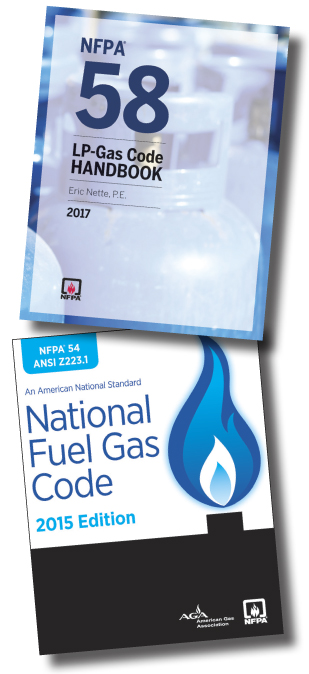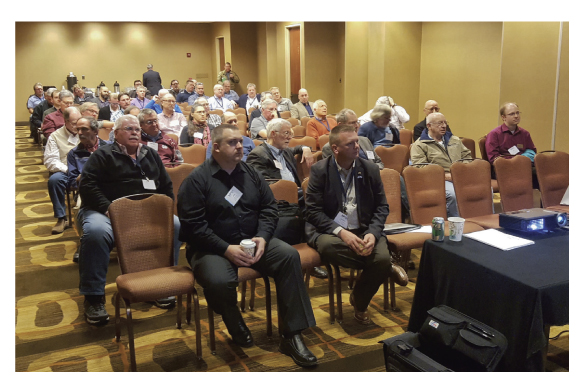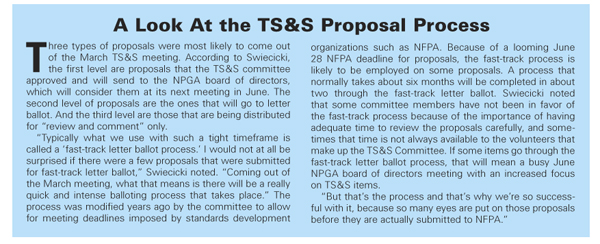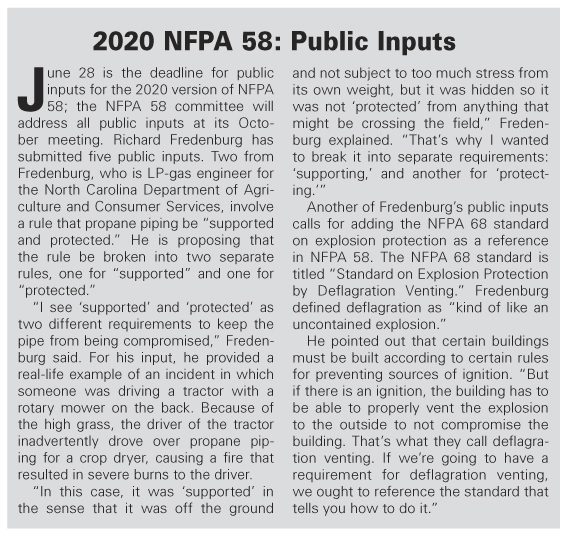Tuesday, April 18, 2017
Bruce Swiecicki was ready for a busy schedule at the March meeting of the National Propane Gas Association (NPGA) Technology, Standards, and Safety (TS&S) Committee meeting in Louisville. Swiecicki, senior technical advisor for NPGA, told BPN that committee members were set to consider several proposals at the TS&S meeting March 13-15, 2017. 
One proposal on the agenda involves clarifying the scope of Chapter 15 of NFPA 58, which deals with maintenance and operations provisions of propane facilities. When it was written more than 15 years ago, the intent of Chapter 14 (it was 14 until it was changed to 15 in the most recent edition) was to address maintenance and operations provisions of bulk plants. But over time, the chapter has evolved to now also include installations providing vapor service only.
“What we’re trying to do is go back to the original intent of that chapter and limit it strictly to bulk plants and industrial plants,” said Swiecicki, who spoke to BPN prior to the TS&S meeting.
He explained that the work on NFPA 58, the Liquefied Petroleum Gas Code, and NFPA 54, the National Fuel Gas Code, is a non-stop cycle. At the March committee meeting, “believe it or not, we’re going to be working on the 2020 edition of NFPA 58.” June 28 is the deadline for proposals for the 2020 edition. “[The TS&S meeting] is going to be very critical in terms of NPGA’s input,” he stressed. At the meeting, committee members would consider several proposals and had just finished a round of letter balloting of eight proposals that came out of its meeting last September. Getting all that work completed is a challenge for the TS&S committee’s 70 voting members and 10 advisory members. The group meets twice a year to develop changes to codes and standards that affect the propane industry. All NPGA members are eligible to participate.
“I’ll tell you, it’s not an easy thing to do, because we’ve got a lot of people to work with, and a lot of them have different perspectives,” Swiecicki said. “That’s usually why we’re so successful with association proposals to the NFPA, because by the time the proposal makes it through the TS&S Committee and gets approved by the board and submitted to NFPA [National Fire Protection Association], it’s usually pretty well debated, and consensus has been formed.” He added that the NFPA Technical Committee is receptive to NPGA proposals, with NPGA boasting a 90% success rate on its proposals and comments.
Swiecicki pointed out that NPGA was successful more than 15 years ago when it turned back some formidable NFPA committee risk-management provisions proposed for NFPA 58. The association was able to prevent the burdensome Risk Management Plan from being incorporated into NFPA 58 and was able to whittle it down to the maintenance and inspection requirements in Chapter 14 (now chapter 15). While the TS&S Committee was set to review that chapter at the March meeting, he emphasized that the committee’s submission of the proposal to NFPA was only tentative. “There are lots of hoops we have to go through, including approval by the [NPGA] board of directors. So there’s no sure thing with any of these proposals.”
He also provided an update on the 2018 version of NFPA 54, the National Fuel Gas Code, which is currently in its revision cycle. NPGA submitted a notice of intent to make a motion, or NITMAM, to remove a requirement regarding the potential change to the air exchange rate between the inside of a building and outside environment due to modifications to the building’s envelope, which may have an impact on the ability of a gas appliance to function safely. NFPA 54 will be presented to the NFPA membership for approval at its June meeting, which Swiecicki described as somewhat of a last-ditch effort for individuals who have complaints or want to see something changed in the standard before it is published. At the meeting, NPGA will endeavor to include a requirement that the contractor performing a modification must make a homeowner aware that when a change is made to the “building envelope,” it may affect the air exchange rate, which may in turn affect the safe operation of the appliance.
Swiecicki explained that a renovation to the exterior envelope of a house could include installing energy-efficient windows, doors, or siding. Following this type of work, it is imperative to ensure adequate air for combustion, ventilation, and dilution of flue gases is available for an appliance such as a furnace or water heater since gas appliances depend on combustion air and dilution air. If a shortage of combustion air exists, the appliance will not achieve complete combustion and it could produce greater-than-normal quantities of carbon monoxide. “It’s very important to have adequate combustion, ventilation, and dilution air into the building,” Swiecicki noted, adding that air often comes in through the walls, windows, and doors of the building, through air exchange that takes place naturally between the inside and outside of the building. When the structure envelope is tighter, getting adequate combustion air needed for the appliance becomes more difficult.
NPGA’s proposal would require a verification that whenever a change is made to the building envelope, it must be verified through a test that adequate air is still available to the appliance. But the homeowner needs to be aware that when a change is made it might affect the safe operation of the gas appliance. The first round of revisions for the 2018 version of NFPA 54 included a provision that the contractor who performs the renovation to the building envelope must verify that the appliances can safely operate and that adequate combustion air and dilution air are brought into the building.
The second revisions to the standard removed the provision placing responsibility on the contractor. “So it’s now left up in the air,” Swiecicki said. “Nobody has been assigned the responsibility to verify that there is adequate combustion air in the building. And when that provision was removed and the contractor is no longer assigned that responsibility, the fear from the NPGA side is that these appliances will now go into operation and there won’t be any indication to the homeowner that there could be a safety issue involved.”
At the June 2017 NFPA meeting, NPGA will argue for the provision of notification to be placed back into the standard. Swiecicki will make a motion to revise the document so that the second revisions that were made are abolished and that NFPA go back to the first revisions, which required the contractor to perform the test and make sure the appliances operate safely.
“The contractor must be made aware, through whatever means, that when the work is done to the building, it could possibly affect the safe operation of those appliances. Before the building is turned over to the homeowner, there must be verification that those appliances can still operate safely. We want to try and avoid a situation in which the homeowner would be put at risk by the modification to his building envelope, without adequate testing to ensure that there will be combustion air and dilution air brought into the building so the appliances will operate safely. And that is the whole premise of the argument that we’re going to make to the NFPA membership.” He explained that dilution air is air that’s necessary to ensure the products of combustion go up the chimney stack or up what is known as the B-vent for gas appliances. “Air that infiltrates the building helps to maintain the necessary pressure inside the building with respect to the outside to allow the products of combustion to be vented properly. Negative pressure inside the building where a natural-draft appliance is installed could result in the products of combustion being sucked back into the building, and you definitely want to avoid that situation.”
A proposal for automatic latching of autogas fill nozzles was also scheduled for discussion at the TS&S meeting. The committee hoped to add the proposal as part of the Underwriters Laboratories standard UL 125. If approved, it would allow the use of a latch-open mechanism to enable propane autogas vehicle users to fill their tanks without continuously having their hand on the nozzle, just as with gasoline-fueled vehicles. UL 125, titled, “Flow Control Valves for Anhydrous Ammonia and LP Gas,” is the flow control valve performance standard that is referenced in NFPA 58.
“If this concept can be adopted into UL 125, that will open the door for the use of a mechanism that would keep the fill process going while the operator walks away to check the oil, or wash the windshield,” Swiecicki explained. “In the propane industry, we don’t currently have the ability to do that. The attendant using the K-15 connection to fill the vehicle must be present and operating the fill valve while the tank is filling.” The proposal has not been decided upon yet, but presumably would call for the addition of a latching device or something similar on a K-15 nozzle that would enable the device to be used for continuous filling. One of the technical hurdles to be faced will be whether an automatic nozzle shut-off device can be implemented, similar to gasoline vehicles, or whether the pump would be allowed to go into bypass mode until the operator stops the filling process. —Daryl Lubinsky

One proposal on the agenda involves clarifying the scope of Chapter 15 of NFPA 58, which deals with maintenance and operations provisions of propane facilities. When it was written more than 15 years ago, the intent of Chapter 14 (it was 14 until it was changed to 15 in the most recent edition) was to address maintenance and operations provisions of bulk plants. But over time, the chapter has evolved to now also include installations providing vapor service only.
“What we’re trying to do is go back to the original intent of that chapter and limit it strictly to bulk plants and industrial plants,” said Swiecicki, who spoke to BPN prior to the TS&S meeting.
He explained that the work on NFPA 58, the Liquefied Petroleum Gas Code, and NFPA 54, the National Fuel Gas Code, is a non-stop cycle. At the March committee meeting, “believe it or not, we’re going to be working on the 2020 edition of NFPA 58.” June 28 is the deadline for proposals for the 2020 edition. “[The TS&S meeting] is going to be very critical in terms of NPGA’s input,” he stressed. At the meeting, committee members would consider several proposals and had just finished a round of letter balloting of eight proposals that came out of its meeting last September. Getting all that work completed is a challenge for the TS&S committee’s 70 voting members and 10 advisory members. The group meets twice a year to develop changes to codes and standards that affect the propane industry. All NPGA members are eligible to participate.
“I’ll tell you, it’s not an easy thing to do, because we’ve got a lot of people to work with, and a lot of them have different perspectives,” Swiecicki said. “That’s usually why we’re so successful with association proposals to the NFPA, because by the time the proposal makes it through the TS&S Committee and gets approved by the board and submitted to NFPA [National Fire Protection Association], it’s usually pretty well debated, and consensus has been formed.” He added that the NFPA Technical Committee is receptive to NPGA proposals, with NPGA boasting a 90% success rate on its proposals and comments.
Swiecicki pointed out that NPGA was successful more than 15 years ago when it turned back some formidable NFPA committee risk-management provisions proposed for NFPA 58. The association was able to prevent the burdensome Risk Management Plan from being incorporated into NFPA 58 and was able to whittle it down to the maintenance and inspection requirements in Chapter 14 (now chapter 15). While the TS&S Committee was set to review that chapter at the March meeting, he emphasized that the committee’s submission of the proposal to NFPA was only tentative. “There are lots of hoops we have to go through, including approval by the [NPGA] board of directors. So there’s no sure thing with any of these proposals.”
He also provided an update on the 2018 version of NFPA 54, the National Fuel Gas Code, which is currently in its revision cycle. NPGA submitted a notice of intent to make a motion, or NITMAM, to remove a requirement regarding the potential change to the air exchange rate between the inside of a building and outside environment due to modifications to the building’s envelope, which may have an impact on the ability of a gas appliance to function safely. NFPA 54 will be presented to the NFPA membership for approval at its June meeting, which Swiecicki described as somewhat of a last-ditch effort for individuals who have complaints or want to see something changed in the standard before it is published. At the meeting, NPGA will endeavor to include a requirement that the contractor performing a modification must make a homeowner aware that when a change is made to the “building envelope,” it may affect the air exchange rate, which may in turn affect the safe operation of the appliance.

Swiecicki explained that a renovation to the exterior envelope of a house could include installing energy-efficient windows, doors, or siding. Following this type of work, it is imperative to ensure adequate air for combustion, ventilation, and dilution of flue gases is available for an appliance such as a furnace or water heater since gas appliances depend on combustion air and dilution air. If a shortage of combustion air exists, the appliance will not achieve complete combustion and it could produce greater-than-normal quantities of carbon monoxide. “It’s very important to have adequate combustion, ventilation, and dilution air into the building,” Swiecicki noted, adding that air often comes in through the walls, windows, and doors of the building, through air exchange that takes place naturally between the inside and outside of the building. When the structure envelope is tighter, getting adequate combustion air needed for the appliance becomes more difficult.

NPGA’s proposal would require a verification that whenever a change is made to the building envelope, it must be verified through a test that adequate air is still available to the appliance. But the homeowner needs to be aware that when a change is made it might affect the safe operation of the gas appliance. The first round of revisions for the 2018 version of NFPA 54 included a provision that the contractor who performs the renovation to the building envelope must verify that the appliances can safely operate and that adequate combustion air and dilution air are brought into the building.
The second revisions to the standard removed the provision placing responsibility on the contractor. “So it’s now left up in the air,” Swiecicki said. “Nobody has been assigned the responsibility to verify that there is adequate combustion air in the building. And when that provision was removed and the contractor is no longer assigned that responsibility, the fear from the NPGA side is that these appliances will now go into operation and there won’t be any indication to the homeowner that there could be a safety issue involved.”
At the June 2017 NFPA meeting, NPGA will argue for the provision of notification to be placed back into the standard. Swiecicki will make a motion to revise the document so that the second revisions that were made are abolished and that NFPA go back to the first revisions, which required the contractor to perform the test and make sure the appliances operate safely.

“The contractor must be made aware, through whatever means, that when the work is done to the building, it could possibly affect the safe operation of those appliances. Before the building is turned over to the homeowner, there must be verification that those appliances can still operate safely. We want to try and avoid a situation in which the homeowner would be put at risk by the modification to his building envelope, without adequate testing to ensure that there will be combustion air and dilution air brought into the building so the appliances will operate safely. And that is the whole premise of the argument that we’re going to make to the NFPA membership.” He explained that dilution air is air that’s necessary to ensure the products of combustion go up the chimney stack or up what is known as the B-vent for gas appliances. “Air that infiltrates the building helps to maintain the necessary pressure inside the building with respect to the outside to allow the products of combustion to be vented properly. Negative pressure inside the building where a natural-draft appliance is installed could result in the products of combustion being sucked back into the building, and you definitely want to avoid that situation.”
A proposal for automatic latching of autogas fill nozzles was also scheduled for discussion at the TS&S meeting. The committee hoped to add the proposal as part of the Underwriters Laboratories standard UL 125. If approved, it would allow the use of a latch-open mechanism to enable propane autogas vehicle users to fill their tanks without continuously having their hand on the nozzle, just as with gasoline-fueled vehicles. UL 125, titled, “Flow Control Valves for Anhydrous Ammonia and LP Gas,” is the flow control valve performance standard that is referenced in NFPA 58.
“If this concept can be adopted into UL 125, that will open the door for the use of a mechanism that would keep the fill process going while the operator walks away to check the oil, or wash the windshield,” Swiecicki explained. “In the propane industry, we don’t currently have the ability to do that. The attendant using the K-15 connection to fill the vehicle must be present and operating the fill valve while the tank is filling.” The proposal has not been decided upon yet, but presumably would call for the addition of a latching device or something similar on a K-15 nozzle that would enable the device to be used for continuous filling. One of the technical hurdles to be faced will be whether an automatic nozzle shut-off device can be implemented, similar to gasoline vehicles, or whether the pump would be allowed to go into bypass mode until the operator stops the filling process. —Daryl Lubinsky

